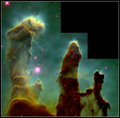Welcome to the Stars!

Many stars are paired.
These are called binary star systems.
Here you will learn about the stars. Did you know that scientist estimate that there are 100 billion stars in the universe! Not only that but stars are like people? They are born, age, and then die. Not only that, but they don't like to be alone! Many stars pair with another star. These star pairs are called binary star systems. Groups of hundreds of stars are called star clusters. Huge organized groups of thousands of stars are called galaxies.
What is a star?

Eagle Nebula
Stars are giant balls of gas that produce heat and radiation. The star that is warmest the earth and is closest to us is our sun of course. Stars are born in nebulae. A nebula is a giant cloud of dust and gas in outer space. A star is formed when gravity forces the gas and dust to compress together creating tremendous energy. There are different types of nebulae. One type is the Stellar Nursery...and you guessed it...this is where stars are born. The Eagle nebula, a famous stellar nursery, looks like it has giant stalagmites in this photo to the right. If you want to learn more about nebulae follow the link to Nebulae-Zoom Astronomy.

Birth of a Star:
Nuclear fusion
There are two basic different types of stars: dwarf stars (average stars), and giant stars. Our sun is an average star. The mass of a star determines its life cycle. The largest stars have the shortest lives, only millions of years. Small stars can live billions of years and the very smallest stars can life for up to a trillion (1,000,000,000,000) years.
Life Cycle of Star
All stars begin as gravity pulls gases and dust closer together creating heat when it begins to glow and nuclear fusion takes place it becomes a protostar (baby star). The protostar will continue to grow. When it stops growing its a main sequence star. when al the fuel for nuclear fusion is used up in a medium star the material in it is pulled in by gravity causing it to shrink. Eventually it becomes a white dwarf. When it stops producing light it becomes a black dwarf.
Medium star's life cycle: protostar ==> main star sequence (yellow) ==> planetary nebula ==> white dwarf ==> black dwarf.
Giant star's life cycle: protostar ==> red supergiant ==> supernova ==> neutron star OR black hole (only the very biggest stars become black holes).
For more information about a star's life cycle read the NASA's StarChild - Level 1) , NASA's StarChild - Level 2. For a graphic version of the cycle see SeaSky.com's Stars (once there scroll down about half way). Then watch this video on how a star is born.
How a Star Lives and DIes
Courtsey of NASA and CalTech
| Oracle's ThinkQuest Stars | Answers questions about stars |
| Stars (Enchanted Learning) | Has detailed information about stars |
| Stars (Cosmic Wonders) | Has great life cycle diagram and detailed explanation about different types of stars. |
Now, take the quiz below:
Star Drawing Mission
Now, your mission is to draw your own diagram of a Stars Life Cycle. You can choose to draw the life cycle of a medium star or a massive star. Make sure to label your diagram. You can choose to draw it using crayons and markers or you can create it on the computer using KidPix.
Have Fun! When you are finished return to the Exploring Planets and Stars web and find out about the night sky!




